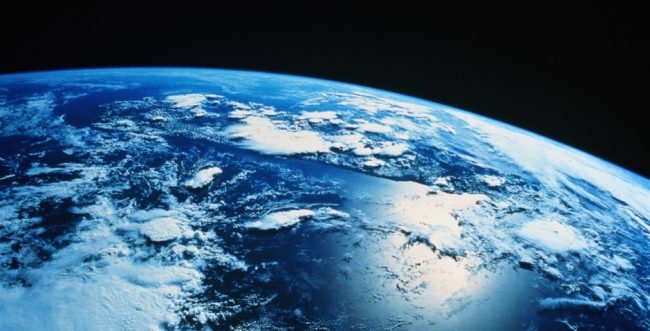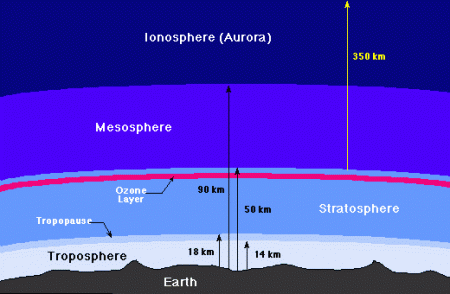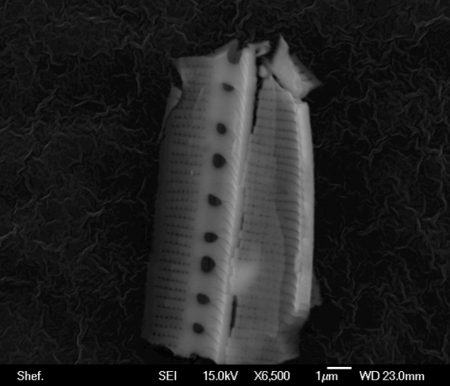Astrobiologists Claim to Have Found Extraterrestrial Life
Form in Earth’s Stratosphere

This image shows a diatom
frustule, possibly a Nitzschia
species, captured on a stud from a height of 25 km in the stratosphere. Image
credit: Milton Wainwright et al.
“Most people will assume that these biological particles must have just drifted up to the stratosphere from Earth, but it is generally accepted that a particle of the size found cannot be lifted from Earth to heights of, for example, 27 km. The only known exception is by a violent volcanic eruption, none of which occurred within three years of the sampling trip,” explained Prof Milton Wainwright from the University of Sheffield, who is a lead author of a paper reporting the discovery in the Journal of Cosmology (full paper).
“In the absence of a mechanism by which large particles like these can be transported to the stratosphere we can only conclude that the biological entities originated from space. Our conclusion then is that life is continually arriving to Earth from space, life is not restricted to this planet and it almost certainly did not originate here.”
“If life does continue to arrive from space then we have to completely change our view of biology and evolution. New textbooks will have to be written!”
The balloon was launched near Chester, UK, and carried microscope studs which were only exposed to the atmosphere when the balloon reached heights of between 22 and 27 km.
The balloon landed safely and intact near Wakefield, UK. The scientists then discovered that they had captured a diatom fragment and some unusual biological entities from the stratosphere, all of which are too large to have come from Earth.
The team is hoping to extend and confirm their results by carrying out the test again in October 2013 to coincide with the upcoming Haley’s Comet-associated meteorite shower when there will be large amounts of cosmic dust. It is hoped that more new, or unusual, organisms will be found.
“Of course it will be argued that there must be an, as yet, unknown mechanism for transferring large particles from Earth to the high stratosphere, but we stand by our conclusions. The absolutely crucial experiment will come when we do what is called ‘isotope fractionation’. We will take some of the samples which we have isolated from the stratosphere and introduce them into a complex machine – a button will be pressed. If the ratio of certain isotopes gives one number then our organisms are from Earth, if it gives another, then they are from space. The tension will obviously be almost impossible to live with!” Prof Wainwright said.
______
Bibliographic information:
Milton Wainwright et al. 2013. Isolation of a diatom frustule fragment from the lower stratosphere (22-27 km) – evidence for a cosmic origin. Journal of Cosmology, vol. 22, pp. 10183 – 10188
Milton Wainwright. Biological entities isolated from the stratosphere (22-27 km): case for their space origin. Conference 8865: Instruments, Methods, and Missions for Astrobiology XVI, Aug. 27, 2013, San Diego, CA, USA. Paper 8865-28
From Sci News @ http://www.sci-news.com/space/science-extraterrestrial-life-form-earth-stratosphere-01393.html
Alien Life Discovered Within the Earth’s Stratosphere?

A new research study claims to have discovered alien life within the Earth’s stratosphere, after deploying a balloon to collect samples at an altitude range of between 22 to 27 kilometers.
The Study

By adopting their stratospheric sampling method, the researchers launched their balloon from Chester, England, during late July of this year. The balloon had a drawer mechanism that could be controlled via telemetry to facilitate acquisition of samples.
Prior to launch, the sample collection drawer was meticulously cleaned, air-blasted and then cleaned with alcohol to ensure it was completely sterilized. Rows of scanning electron microscope (SEM) stubs were positioned along the base of the drawer, facing upward, to allow particulate matter to settle for later microscopic analysis.
Upon arrival within the stratosphere, the balloon commenced its collection. The drawer was opened for a period of 17 minutes, between the altitudes of 22026m to 27008m, to allow microbes to be captured by the stubs. The sampling equipment was subsequently returned to Earth, via parachute.
The Frustule Finding

Scanning electron microscope image of the diatom frustule
Lead author of the study, Milton Wainwright, of the University of Sheffield, discusses the implications of his team’s research. With no other mechanisms to explain their findings, he suggests the origins of these “biological entities” must be from space, and are systematically delivered to the Earth’s stratosphere.
He stipulates that particulate the size of diatoms cannot be simply “lifted” from our planet to elevations of 27km. Only a violent outburst from a volcano could be responsible for delivering such particulate to the stratosphere, says Wainwright.
However, with regards to his own study, Wainwright dismisses this contingency, since no volcanic eruptions had taken place three years prior to the balloon’s sampling trip. The study also points out that large, dense organic material, including diatoms, would experience a relatively short “residence time” within the stratosphere.
Scientific Opposition
Seth Shostak of the Search for Extraterrestrial Intelligence (SETI) Institute has reservations about the study. Although he believes in the widespread notion that extraterrestrial life can hitch a ride on the back of comets (panspermia), he considers the fallibility of the researchers’ methodology.
In the past, analogous research studies have utilized similar approaches to search for alien life. However, speaking to Space.com, Shostak maintains “… most members of the astrobiology community have found it easier to ascribe these claims to terrestrial contamination…”
Responding to critics, the authors refute the possibility of contamination from the balloon itself:
“… this criticism emphatically does not apply to the diatom frustule… simply because diatoms do not occur on pristine balloons, in laboratory air, nor are they associated with laboratory workers. The methods used to clean the sampling apparatus would also prevent such contamination, as would the approaches used to maintain sterility before the E/M stubs were exposed to the stratosphere.”
The study also refers to “unthinking critics,” who fail to take into consideration that diatom particles cannot simply float into the stratosphere. The authors also rule out the possibility of contamination from commercial aircraft, which fly too low; likewise, blue lightning would be unable to elevate heavy diatoms into the stratosphere.
Meanwhile, Chris McKay suggests the evidence is not substantial enough to warrant these audacious claims, inferring the authors of the paper have made a “big jump” with their conclusions. He suggests that proving the organisms have some obvious biochemical differences from life on Earth, for example, could constitute evidence that would provide more credence to their claims.
The authors plan to perform further experiments on their stratosphere-derived samples, in a bid to prove their theory that tiny alien life forms are constantly arriving from space. Hopefully, more discoveries await.
Journal of Cosmology Source
Live Science Link
From Guardian Liberty Voice @ http://guardianlv.com/2013/09/alien-life-discovered-within-the-earths-stratosphere/
New Alien Life Claim Far from Convincing, Scientists Say
By Mike Wall

Comets
contain elements such as water, ammonia, methanol and carbon dioxide that
could have supplied the raw materials to help jump-start life on Earth. Some
researchers even think the icy objects may have transported life to our
planet from afar.
Credit: Lawrence Livermore National Laboratory
Credit: Lawrence Livermore National Laboratory
A new study that claims to present evidence of alien life is being met with a healthy dose of skepticism in the scientific community.
On July 31, a team of British researchers sent a balloon into the stratosphere over England, where it collected samples at an altitude range of 14 miles to 17 miles (22 to 27 kilometers). The balloon's scientific payload returned to Earth toting the cell wall, or frustule, of a type of microscopic algae called a diatom, the scientists report in the Journal of Cosmology.
While bacteria and other tiny lifeforms have been found high above the planet before — storm clouds are teeming with microbes, for example — the new discovery is potentially of monumental importance, study team members say. [5 Bold Claims of Alien Life ]
"Most people will assume that these biological particles must have just drifted up to the stratosphere from Earth, but it is generally accepted that a particle of the size found cannot be lifted from Earth to heights of, for example, 27 km. The only known exception is by a violent volcanic eruption, none of which occurred within three years of the sampling trip," lead author Milton Wainwright, of the University of Sheffield in the United Kingdom, said in a statement Thursday (Sept. 19).
"In the absence of a mechanism by which large particles like these can be transported to the stratosphere, we can only conclude that the biological entities originated from space," Wainwright added. "Our conclusion then is that life is continually arriving to Earth from space, life is not restricted to this planet and it almost certainly did not originate here."
The diatom fragment may have been delivered to Earth by a comet, Wainwright and his colleagues write in the paper, which can be read here at the Journal of Cosmology.
Extraordinary
claims require extraordinary evidence
The idea that life is widespread throughout the universe and has been transported to many worlds by objects such as comets — a notion known as panspermia — is credible, at least over relatively short cosmic distances, said astronomer Seth Shostak of the SETI (Search for Extraterrestrial Intelligence) Institute in Mountain View, Calif.
However, that doesn't necessarily mean the new study will stand up to the intense scientific scrutiny it's likely to receive, he said.
"In the past, most members of the astrobiology community have found it easier to ascribe these claims to terrestrial contamination than to extraterrestrial hitchhikers," Shostak told SPACE.com via email. "It remains to be seen whether that opinion will be changed by these new results." [10 Alien Encounters Debunked]
Indeed, other scientists said they would like to see more convincing evidence of a cosmic origin for the organism snagged by the balloon.
"There is probably truth to the report that they find curious stuff in the atmosphere," Chris McKay, an astrobiologist at NASA's Ames Research Center in Moffett Field, Calif., told SPACE.com via email. "The jump to the conclusion that it is alien life is a big jump and would require quite extraordinary proof. (The usual Sagan saying: extraordinary claims require extraordinary evidence.)"
McKay gave an example of what might constitute such extraordinary evidence.
"If they were able to show that it was composed of all D amino acids (proteins in Earth life are made of L amino acids), that would be pretty convincing to me," he said. "So some sort of biochemical indication that it does not share Earth biochemistry. If it does indeed share Earth biochemistry, proving that it is of alien origin is probably impossible."
Further study
needed
Wainwright and his team plan to study their stratospheric samples further in an attempt to find a smoking gun for an off-Earth origin. For example, the researchers will analyze the ratios of various isotopes, which are varieties of an element that have different numbers of neutrons in their atomic nuclei.
"If the ratio of certain isotopes gives one number, then our organisms are from Earth; if it gives another, then they are from space," Wainwright said.
However, astrobiologist Dirk Schulze-Makuch of Washington State University thinks the study team should have performed such follow-up analyses, and consulted diatom experts, before publishing its provocative claim.
"Perhaps the fragment came actually from the stratosphere and is not contamination, but basing this conclusion only on one particle and very limited analysis seems quite odd to me and inferring an extraterrestrial origin completely off-base," Schulze-Makuch told SPACE.com via email.
Schulze-Makuch also thinks comets are unlikely incubators for life, suspecting that life first arose on a planetary body. And the presence of a diatom on a comet would be especially surprising, he said.
"Diatoms are actually relatively advanced life forms on Earth and developed most likely sometime at the beginning of the Mesozoic (probably Jurassic time period), thus very late during evolution (probably at least 3 billion years after the origin of life on Earth)," Schulze-Makuch said, adding that diatoms are typically aquatic and there is no liquid water on a comet, except during the brief periods when the icy objects approach the sun.
"Besides, I would expect an extraterrestrial organism or even remnant of an organism to be quite different from what we see on Earth in some significant ways (as the environment around it, its 'habitat,' will affect the form and function of the organism), and certainly not be linked to some kind of diatom species on Earth," Schulze-Makuch said.
Other
controversial claims
The Journal of Cosmology is no stranger to bold claims. Two years ago, for instance, it published a controversial study that purported to have found evidence of fossilized life in meteorites.
That paper was not well received by outside scientists, some of whom questioned the journal's credibility as well.
"It isn't a real science journal at all, but is the ginned-up website of a small group of crank academics obsessed with the idea of [Fred] Hoyle and [Chandra] Wickramasinghe that life originated in outer space and simply rained down on Earth," P.Z. Myers, a biologist at the University of Minnesota, Morris, wrote on his popular science blog Pharyngula at the time.
Wickramasinghe is a co-author of the new stratospheric diatom paper, a fact that could color its reception in the wider scientific community.
"I don't have ANY expertise in this area," Rosie Redfield, a microbiologist at the University of British Columbia, told SPACE.com via email. Redfield was among the outspoken critics of the Journal of Cosmology's 2011 meteorite announcement. "But neither the Journal of Cosmology nor Dr. Wickramasinghe have any scientific credibility, and one fragment of a diatom frustule is hardly significant evidence."
From Space.com @ http://www.space.com/22875-alien-life-claim-space-microbes.html
For more information about extraterrestrial life see http://nexusilluminati.blogspot.com/search/label/extraterrestrial%20life
- See ‘Older Posts’ at the end of each section
Hope you like this
not for profit site -
It takes hours of work every day
to maintain, write, edit, research, illustrate and publish this website from a
tiny cabin in a remote forest
Like what we do? Please give enough
for a meal or drink if you can -
Donate any amount and receive at least one New Illuminati eBook!
Please click below -
For further enlightening
information enter a word or phrase into the random synchronistic search box @ http://nexusilluminati.blogspot.com
And see
New Illuminati – http://nexusilluminati.blogspot.com
New Illuminati on Facebook - https://www.facebook.com/the.new.illuminati
New Illuminati Youtube Channel - http://www.youtube.com/user/newilluminati/feed
New Illuminati on Google+ @ https://plus.google.com/115562482213600937809/posts
New Illuminati on Twitter @ www.twitter.com/new_illuminati
The Her(m)etic Hermit - http://hermetic.blog.com
The Prince of Centraxis - http://centraxis.blogspot.com (Be Aware! This link leads to implicate &
xplicit concepts & images!)
DISGRUNTLED SITE ADMINS PLEASE NOTE –
We provide a live link to your original material on your site (and
links via social networking services) - which raises your ranking on search
engines and helps spread your info further! This site is
published under Creative Commons Fair Use Copyright (unless an individual
article or other item is declared otherwise by the copyright holder) –
reproduction for non-profit use is permitted & encouraged, if you
give attribution to the work & author - and please include a (preferably
active) link to the original (along with this or a similar notice).
Feel free to make non-commercial hard (printed) or software copies or
mirror sites - you never know how long something will stay glued to the web –
but remember attribution! If you like what you see, please send a donation (no
amount is too small or too large) or leave a comment – and thanks for reading
this far…
Live long and prosper! Together we can create the best of all possible
worlds…
From the New
Illuminati – http://nexusilluminati.blogspot.com
Those diatoms are from earth, unless proven to be alien. Blue Jets, sprites, extend far beyond the sratosphere and can easily send them aloof from the ocean.
ReplyDeleteIt's possible, and Occam's razor may be on your side - but it cuts both ways. Expert advice claims that diatoms of this weight are very unlikely to remain aloofly aloft in the stratosphere
ReplyDelete